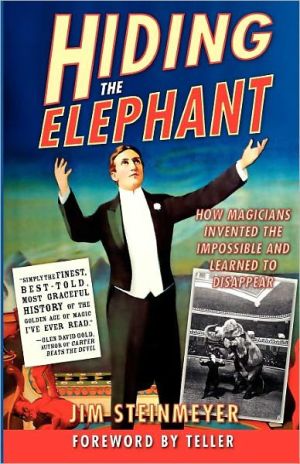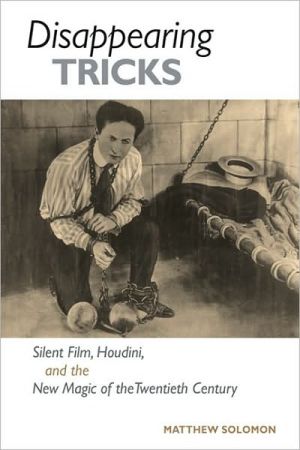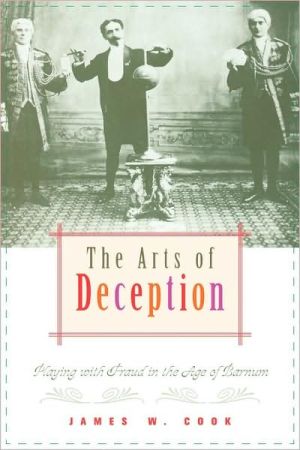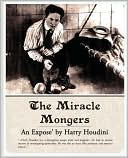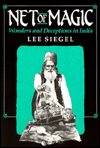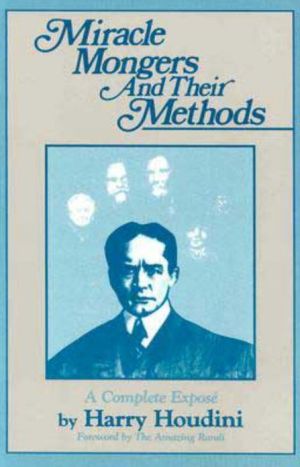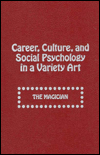Hiding the Elephant: How Magicians Invented the Impossible and Learned to Disappear
Now in paperback comes Jim Steinmeyer's astonishing chronicle of half a century of illusionary innovation, backstage chicanery, and keen competition within the world of magicians. Lauded by today's finest magicians and critics, Hiding the Elephant is a cultural history of the efforts among legendary conjurers to make things materialize, levitate, and disappear. Steinmeyer unveils the secrets and life stories of the fascinating personalities behind optical marvels such as floating ghosts...
Search in google:
Now in paperback comes Jim Steinmeyer’s astonishing chronicle of half a century of illusionary innovation, backstage chicanery, and keen competition within the world of magicians. Lauded by today’s finest magicians and critics, Hiding the Elephant is a cultural history of the efforts among legendary conjurers to make things materialize, levitate, and disappear. Steinmeyer unveils the secrets and life stories of the fascinating personalities behind optical marvels such as floating ghosts interacting with live actors, disembodied heads, and vanishing ladies. He demystifies Pepper’s Ghost, Harry Kellar’s Levitation of Princess Karnak, Charles Morritt’s Disappearing Donkey, and Houdini’s landmark vanishing of Jennie the elephant in 1918. The dramatic mix of science and history, with revealing diagrams, photographs and magicians' portraits by William Stout, provides a glimpse behind the curtain at the backstage story of magic. The New York Times Steinmeyer writes about events a century ago as vividly as if he had been there; and in a sense, he has been … the true subject of Hiding the Elephant is not Houdini's trick, or the technology of magic or its colorful history. This book is about how it feels to be a magician -- not a romantic Robertson Davies fantasy but a craftsman and laborer in drafty backstages, ever in search of subtler ways to build miracles out of contradictory fragments of drab reality. No author has ever better conveyed the way the love of conjuring consumes a magician's life with magic's joys, terrors and longings. — Teller
HIDING THE ELEPHANT\ How Magicians Invented the Impossible and Learned to Disappear \ \ By JIM STEINMEYER \ Carroll & Graf Publishers\ Copyright © 2003 Jim Steinmeyer\ All right reserved.\ ISBN: 0-7867-1226-0 \ \ \ \ Chapter One\ At the height of his career, during the longest continuous theatrical run of his lifetime, Harry Houdini boldly marched to the edge of the stage at the New York Hippodrome and propelled his voice across the footlights to an expectant crowd of 5200 people, announcing his newest headline-making innovation. \ "Lay-deeahs and gintle-menh," he began, holding a finger upright. "Perhaps you have all-red-dy heard of the fame and a-comp-lish-ments of my spesh-shel guest!" The world-famous daredevil, escape artist, self-liberator, movie star, publicity genius, and mystery performer was in real life a little man. On the enormous stage of the Hippodrome, he seemed even smaller, but he compensated with an outsized energy, just as he had corrected a thick East Side of Manhattan accent by overenunciating each syllable; his words stabbed the back wall of the theatre like a knife. "Allow me to in-tro-duce Jennie! The world's only vanishing ell-ee-phant!"\ Crowds expected a lot at the Hippodrome. The theatre was famous for its ambitious productions, bigger, better, more opulent, and more spectacular than any other vaudeville show. Audiences had seen entire armies invade the stage, marching bands, cavalry charges, and zeppelin attacks. They had craned their necks as the circus acts performed overhead, and they had inched forward in their red plush seats as an earthquake-like rattle seemed to dislodge the wide wooden platform. Slowly, the famous stage sank out of sight, revealing torrents of water, that bubbled up to fill a large tank. Enter the boats, the water ballet, and diving horses.\ A Hippodrome show was a special treat for New Yorkers and out-of-town guests, but it was never sophisticated entertainment, with the pretensions of the Broadway revues or plays one block west on Seventh Avenue. The Hippodrome was designed to make audiences gasp, smile, and write home about. This particular show, titled "Cheer Up," predictably included a patriotic medley filled with hundreds of American soldiers. Houdini was the guest act and had been included halfway through the run of the show in order to give it a boost of publicity and attract new crowds.\ It was fitting that Houdini had chosen the Hippodrome for the premiere of the largest illusion ever attempted. Even the decor of the theatre was a perfect match-Moorish filigree and white marble, and hundreds of gilt elephant heads adorning the electric wall sconces and the tops of each column.\ As Houdini completed his introduction, an animal trainer dashed onto the stage, leading Jennie, a full-grown Asian elephant. The ample backstage space at the Hippodrome gave her plenty of room to make a spectacular entrance, running at full speed as she came into view, circling Houdini in wide arcs, shaking her head from side to side with each stride. Jennie was nearly eight feet tall and weighed over six thousand pounds, monstrous and graceful at the same time. The audience likely recognized her as one of Powers' Elephants, a group of performing pachyderms that were regularly featured in Hippodrome revues. For this performance she wore a gigantic baby-blue ribbon around her neck and a "wristwatch"-an alarm clock tied around her hind leg. Jennie stopped in the center of the stage; she stood on her back legs, saluted the audience by raising her trunk, and finally reached over to Houdini to give him a slobbery kiss. He rewarded her with a handful of sugar cubes and joked about how she was contributing to the sugar shortage caused by the Great War.\ The curtain opened on an oversized wooden box, about the dimensions of a small garage and decorated like a brightly colored circus wagon. It was raised off the stage by large wheels. As a Sousa march rumbled from the orchestra, the trainer led Jennie stoically up a ramp, through two opened doors, and into the box. Few in the audience would notice this point: It wasn't simply the Vanishing Elephant, but the Vanishing Elephant and Trainer. The doors were then closed as a crew of Hippodrome stagehands in white uniforms and cotton gloves leaned against the corners of the box, slowly giving the circus wagon a quarter turn.\ The audience might have suspected that the great beast would be lowered through the floor into the famous Hippodrome water tank, but as the box was raised on wheels, it was plain that Jennie was still inside. The apparatus was far from the curtains, isolated in the center of the vast stage.\ Houdini, now little more than a black speck hovering in front of the action, signaled for the orchestra to stop. "Watch closely ... for it happens in two sec-conds," he proclaimed. The whole operation had in fact taken several minutes to this point, but no one would quibble with his exaggeration. Drumroll. He clapped his hands, and the stagehands, taking their cue, quickly ran to the opposite ends of the circus wagon. They reached over and opened circular doors, cutout panels in the ends of the wagon so the audience could look straight through the box to the bright curtains hanging at the back of the stage. A loud crash chord, and Houdini turned to face the audience. "You can plainly see ... the an-nee-mile is com-plete-ly gone!" Houdini was right. The box really looked empty.\ The Great Houdini bowed deeply as the front curtains closed. Amazing. And then the most amazing part: The Hippodrome patrons squinted at the scene, mumbled to themselves, and let go with what seemed a collective shrug, contemplating the next feature on the busy program: a trapeze act. They'd just seen the most gigantic wonder ever presented on a stage yet greeted it with only a deflating smattering of applause.\ Houdini was a terrible magician.\ That's not how he's remembered, of course. But to his public, during the first decades of the twentieth century, Houdini wasn't thought of as a magician at all; he was the escape artist, the fellow who got out of jails, swam to the surface after being nailed in a box and thrown into the river, or wriggled out of a straitjacket while dangling upside-down from the cornice of a building. Houdini was fiercely proud of his escape specialty; it was his innovative, new act that had made his name on vaudeville and music hall stages. His sensational challenges as an escape artist had quickly given Houdini legendary status, which transcended the variety stage and make him the envy of magicians, comedians, jugglers, and singers. He was no mere amusement; he was a myth: a lone figure who challenged the system, a hero who refused to be restrained.\ As far as audiences were concerned, there were other men who were great magicians, like Howard Thurston, who toured American cities every year with his big show and covered the sides of buildings with his colorful posters. In London there was David Devant, of the famous Maskelyne and Devant Theatre of magic, who produced solid ivory billiard balls between his fingertips or performed in dramatic plays featuring stage illusions. In one of his most memorable effects, he made a lady disappear in the middle of a well-lit stage; as he attempted to embrace her, she seemed to dissolve into thin air. In vaudeville you could see T. Nelson Downs, whose specialty was sleight of hand with hundreds of silver dollars, or P.T. Selbit, who toured with famous mysteries like Sawing through a Woman or Crushing a Lady.\ Houdini was about something altogether different. He was not especially graceful or elegant, as magicians were expected to be, but was a restless collection of shapes: slightly bowlegged, with muscular shoulders and a triangular face. He'd found his calling with the escape act, which complemented his brash, rough-around-the-edges appearance. But Houdini desperately wanted to be a magician, a real magician.\ Houdini's Vanishing Elephant was the result of over fifty years of careful experiments by stage magicians in France, England, and the United States; it was also a secret that had been purchased by Houdini and the latest flourish in his spectacular career, spanning a lifetime of theatrical mysteries. The man behind the trick remains a puzzle. Harry Houdini was a famously complicated personality, and much of his life seemed to consist of dares, challenges and denouncements, which were played out in his vaudeville act. He had been born Erich Weiss in 1874, and his early inspiration was the romantic, adventurous autobiography of Jean Robert-Houdin, the Parisian magician of the mid-1800s. The Memoirs of Robert-Houdin so influenced him that he took a stage name derived from Robert-Houdin's as an homage.\ Robert-Houdin's book was filled with his picaresque adventures, brushes with royalty, and dramatic triumphs over superstitious tribes in Algeria, who deeply believed in magic and were cowed by the French master. Renowned as the "Father of Modern Magic," Robert-Houdin had a short but spectacular career. In 1845 he opened his own theatre in Paris and performed elegant, sophisticated conjuring. His illusions were ingeniously combined with mechanical figures, called automata, which he constructed.\ Such a world must have seemed like a wonderful dream to young Erich. He quickly learned the rudiments of the craft, endlessly practicing the maneuvers in Robert-Houdin's own guide to sleight of hand and swapping the latest secrets at the local magic shop. Robert-Houdin had written of his overnight success in magic, instant acceptance into the world of Parisian society, and his glittering career. He was celebrated in the capitals of Europe for his ingenious deceptions and inventions. Houdini found work in grimy dime museums, the big-city versions of sideshows, where the magic act was given a few short minutes to impress the crowd as they paraded past a row of human oddities. Houdini's first successes consisted of the usual handkerchief and card tricks; for a while he billed himself as the "King of Cards," trying to impress audiences with his newly mastered manipulations and flourishes. He worked on the midway at the Chicago Columbian Exposition in 1893; in a burlesque show in Manchester, New Hampshire; on the platform of a medicine show in Kansas; and in a small tent circus through Pennsylvania, where he presented a magic act, performed as a singing clown, and then muddied his face and climbed into a cage to appear as the "wild man." Show business for him was not very much like the world of Robert-Houdin.\ Houdini's beloved innovations, the escape tricks that set him apart and gradually became the staple of his act, were derived from traditional magic. The Davenport brothers, New York performers in the 1860s, had presented an act in which they were tied securely inside a large wooden cabinet. When the cabinet was closed, a series of chilling, ghostly manifestations was produced from the cabinet. The brothers secretly escaped from the ropes to orchestrate the illusions, and then retied themselves before the cabinet was opened again. Houdini's act emphasized the freedom rather than the spirits, challenging his audience to restrain him with ropes, chains, or handcuffs. John Nevil Maskelyne of London had introduced the escape from a sealed trunk around the time Erich was born. Maskelyne's escape required several minutes as the trunk was concealed inside a cabinet. Houdini increased the pace of the trunk escape, calling it Metamorphosis. He would be locked inside the trunk, which was then hidden by a curtain. Houdini's brother, outside the trunk, clapped his hands three times, signaling three seconds. When the curtain was pulled open, they'd changed places. Houdini was outside the trunk. His brother was now securely locked inside.\ His escapes, not the card tricks or handkerchief tricks, made Houdini a success. Vaudeville theatres and music halls were always anxious for the latest novelty. Houdini's remarkable iconography-the little man taking on the bonds of society-was evidenced in the elaborate challenges that he proudly accepted. In London in 1904, early in his career, Houdini was dared to escape from a special pair of handcuffs that had taken a proud British workman five years to make; they were designed using the famous "pick-proof" Bramah lock, the pride of English machining. Houdini hesitated. The Daily Illustrated Mirror formalized the contest, wondering if the smart-talking Yank was worthy of his reputation. The next day, thousands crowded into a London theatre to watch Houdini take on the Mirror's cuffs. They were clamped on his wrists, the key turned, and he retired inside a small curtained cabinet to begin his work in secret.\ The following seventy minutes are legendary. After working diligently in his cabinet for over half an hour, Houdini emerged perspiring, with his collar pulled away. The audience was ready to applaud but was disappointed to see the cuffs still firmly in place. Houdini asked that the lock be opened so he could remove his coat. The audience groaned. The representative of the paper demurred. After all, this was an obvious ruse to see how the lock operated. No, he refused to open the cuffs unless Houdini admitted defeat. The audience must have shared in this opinion. The wily American was trapped, suggesting a transparent excuse to gain his advantage.\ Houdini shrugged, pulled a penknife from his pocket, opened it, and held it in his teeth. He gathered his frock coat over his arms so that it hung at his wrists, and dramatically shredded the coat with the knife, bit by bit, until he could pull the pieces away from the handcuffs: dared, defied, defiant. The audience whooped and cheered. Houdini disappeared back into his cabinet.\ The band played on for almost 30 minutes longer. Houdini readjusted the curtains to get a better look at the lock; he called for a glass of water. Suddenly, he bounded from the cabinet, free of the impenetrable cuffs.\ The audience nearly rioted. Houdini sobbed in relief; the committee onstage hoisted him to their shoulders and carried him around the theatre as handkerchiefs were waved and the crowd shouted their approval. It took one hour and ten minutes for Houdini to play all the parts: outsider, bounder, conniver, then victim, gentleman, hero.\ The current opinion, based on experts who have examined the Mirror handcuffs and the records of the event, is that Houdini had staged it all. He had the cuffs made and then entrusted them to a man who would deceptively step forward to "challenge" him, and this careful preparation seems consistent with the way he went about all of his escapes. Houdini took bold challenges for his publicity; he seldom took real chances with his escapes. Ultimately, well-reported episodes like the escape from the Mirror cuffs made Houdini's reputation as a determined, mysterious master of locks. There wasn't anything magical about it, even if the performance was a glorious deception.\ \ Continues...\ \ \ \ Excerpted from HIDING THE ELEPHANT by JIM STEINMEYER Copyright © 2003 by Jim Steinmeyer. Excerpted by permission.\ All rights reserved. No part of this excerpt may be reproduced or reprinted without permission in writing from the publisher.\ Excerpts are provided by Dial-A-Book Inc. solely for the personal use of visitors to this web site. \ \
List of IllustrationsCast of CharactersIntroduction1Overture12The Ghost193A New Type of Magic454The Formula for Invisibility715The Chief916Two Wizards1157Father and Son1378Stealing Secrets1599Special Effects17710Magic Words19711Solomon21912Houdini23913Jennie25714Sensations27515Keeping Secrets29716Encore317Acknowledgments and Notes333Index353
\ The New York TimesSteinmeyer writes about events a century ago as vividly as if he had been there; and in a sense, he has been … the true subject of Hiding the Elephant is not Houdini's trick, or the technology of magic or its colorful history. This book is about how it feels to be a magician -- not a romantic Robertson Davies fantasy but a craftsman and laborer in drafty backstages, ever in search of subtler ways to build miracles out of contradictory fragments of drab reality. No author has ever better conveyed the way the love of conjuring consumes a magician's life with magic's joys, terrors and longings. — Teller\ \ \ \ \ Publishers WeeklyThe success of a magician "lies in making a human connection to the magic." Create an illusion in the audience's mind, and they're hooked. But to understand magicians, we need to understand the art of that creation. Steinmeyer, who has designed illusions for Siegfried and Roy and David Copperfield, presents a cultural history of magic's golden age (from the 1890s to the 1930s), some legendary tricks (including the Levitation of Princess Karnak and Harry Houdini's Disappearing Elephant) and the fierce rivalries that dominated the craft. Steinmeyer reveals certain secrets, which rely on engineering, artistry and sheer chutzpah, but he hasn't betrayed anyone; most of his information has been published elsewhere. What he adds is context. Magicians advertise deceit, then perform it. Unlike political chicanery, which Steinmeyer dubs dishonest trickery, magic is a kind of pure trickery. Audiences pay for a ruse, not a lecture on fraud. Do we believe movie special effects are real? Of course not, but it doesn't detract from our enjoyment. Similarly, while many 19th-century spiritualists were rightfully debunked as frauds and charlatans, audiences loved the antics. Some, such as the Davenport brothers, were a magnet of controversy and a wild hit, successfully mixing "religion, agnosticism, science, superstition, and fraud." Steinmeyer diagrams famous tricks, celebrating their science and ingenuity. Readers meet characters as colorful as their acts. Buyer beware: If you want to keep your illusions, go to Las Vegas. But for magic lovers who revel in learning the magician's art, this book part research study, part salute is a find. 8 pages of b&w photos and diagrams. (Nov.) Forecast: Readers who clamored for David Blaine's Mysterious Stranger last year will want to add Steinmeyer's book to their collection. Copyright 2003 Reed Business Information.\ \ \ Kirkus ReviewsA good-natured, respectful, and modestly revelatory excursion through a century of the magic arts from one of the innovators of the game. "My experience tells me that the story of magicians can only be understood when you understand their art. And the secrets are only impressive when you understand the people responsible, the theatrics, and the history surrounding them," writes illusionist Steinmeyer, who then genially proceeds to introduce the great magicians from the mid-19th to mid-20th centuries: David Devant, Alexander Herrmann, the Meskelynes, and Howard Thurston. Harry Houdini is dismissed as a "terrible magician," though as an escape artist he was in the firmament, and his disappearing elephant does capture Steinmeyer’s imagination, if only for its magnitude and bravura. They were all, Steinmeyer writes, comfortable in both the worlds of theater and science, likely to cultivate reputations for travel to lands of wonder—the Indian subcontinent or the Himalaya of flying monks. With low-key panache, Steinmeyer clues us in on smoke and angles, sightlines and dark pits, synchronized counting, distraction, the gooseneck that allowed a hoop to pass around a levitating body, the exploitation of audiences’ anticipations, preconceptions, and assumptions—though sadly, we learn, many a neat trick went to the grave with its creator. Mostly, though, Steinmeyer tells of mirrors and panes of glass, of the optical formulas for invisibility. Need an elephant to vanish? Get a big mirror and a good angle. For other disappearing acts, build a Porteau Cabinet or a Corsican Trap, a Maskelyne’s Gorilla Den or Davenport Spirit Cabinet. Each works with mirrors, and Steinmeyer explains how (thoughrope tricks remain difficult to grasp after what appears—remember, never trust appearances in the company of magicians—a very clear explanation). Steinmeyer never tenders a deflating moment, even after the tricks are turned inside out. A buoyant articulation of the brilliance and brains behind the best artists’ ingenious feats. (Illustrations) Agent: Jim Fitzgerald/Carol Mann Agency\ \
